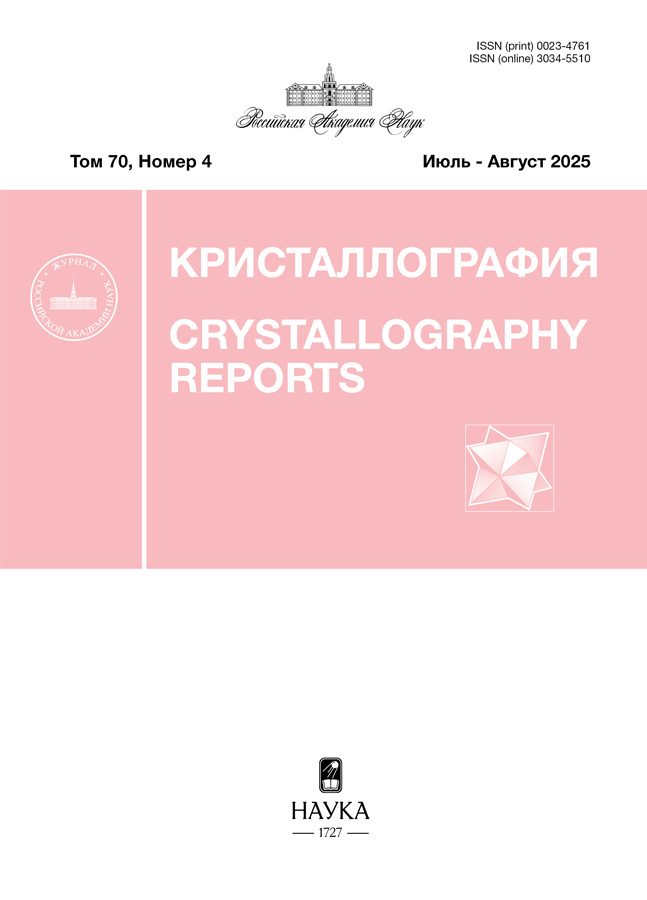Атомистическое моделирование кристалла парателлурита α-teo2. I. Дефекты и ионный перенос
- Авторы: Иванов-Шиц А.К.1
-
Учреждения:
- Институт кристаллографии им. А.В. Шубникова Курчатовского комплекса кристаллографии и фотоники НИЦ “Курчатовский институт”
- Выпуск: Том 69, № 6 (2024)
- Страницы: 1009-1017
- Раздел: ФИЗИЧЕСКИЕ СВОЙСТВА КРИСТАЛЛОВ
- URL: https://ter-arkhiv.ru/0023-4761/article/view/673630
- DOI: https://doi.org/10.31857/S0023476124060116
- EDN: https://elibrary.ru/YGWVEB
- ID: 673630
Цитировать
Полный текст
Аннотация
С помощью методов компьютерного моделирования исследованы структурные и дефектные особенности кристаллов парателлурита α-TeO2. Показано, что в α-TeO2 предпочтительными точечными дефектами являются кислородные вакансии и междоузельные ионы кислорода. Вакансии кислорода могут быть как изолированными, так и образовывать сложные кластеры. Междоузельным ионам кислорода энергетически выгоднее всего располагаться в каналах, пронизывающих структуру парателлурита вдоль оси с. Обсуждается природа возможного кислород-ионного переноса в α-TeO2.
Полный текст
Об авторах
А. К. Иванов-Шиц
Институт кристаллографии им. А.В. Шубникова Курчатовского комплекса кристаллографии и фотоники НИЦ “Курчатовский институт”
Автор, ответственный за переписку.
Email: alexey.k.ivanov@gmail.com
Россия, Москва
Список литературы
- Кондратюк И.П., Мурадян Л.А., Писаревский Ю.В. и др. // Кристаллография. 1987. Т. 32. С. 609.
- Thomas P.A. // J. Phys. C. 1988. V. 21. P. 4611. http://stacks.iop.org/0022-3719/21/i=25/a=009
- Дудка А.П., Головина Т.Г., Константинова А.Ф. // Кристаллография. 2019. Т. 64. С. 930. https://doi.org/10.1134/S0023476119060043
- Ceriotti M., Pietrucci F., Bernasconi M. // Phys. Rev. B. 2006. V. 73. P. 104304. https://doi.org/10.1103/PhysRevB.73.104304
- Champarnaud-Mesjard J.C., Blanchandin S., Thomas P. et al. // J. Phys. Chem. Solids. 2000. V. 61. P. 1499. https://doi.org/10.1016/S0022-3697(00)00012-3
- Малютин С.А., Саплавская К.К., Карапетьянц М.Х. // Журн. неорган. химии. 1971. Т. 16. С. 781.
- Deringer V.L., Stoffel R.P., Dronskowski R. // Cryst. Growth Des. 2014. V. 14. P. 871. http://doi.org/10.1021/cg401822g
- Uchida N., Ohmachi Y. // J. Appl. Phys. 1969. V. 40. P. 4692. https://doi.org/10.1063/1.1657275
- Arlt G., Schweppe H. // Solid State Commun. 1968. V. 6. P. 783. https://
- Gupta N., Voloshinov V. // Opt. Lett. 2005. V. 30. P. 985. https://doi.org/10.1364/OL.30.000985
- Wang P., Zhang Z. // Appl. Opt. 2017. V. 56. P. 1647. https://doi.org/10.1364/AO.56.001647
- El-Mallawany R.A.H. Tellurite Glasses Handbook: Physical Properties and Data; CRC Press: Boca Raton, FL, 2002.
- Li Y., Fan W., Sun H. et al. // J. Appl. Phys. 2010. V. 107. P. 093506. https://doi.org/10.1063/1.3406135
- Liu Z., Yamazaki T., Shen Y. et al. // Appl. Phys. Lett. 2007. V. 90. P. 173119. https://doi.org/10.1063/1.2732818
- Ковальчук М.В., Благов А.Е., Куликов А.Г. и др. // Кристаллография. 2014. Т. 59. С. 950.
- Куликов А.Г. // Образование приповерхностных структур в кристаллах парателлурита и тетрабората лития при миграции носителей заряда во внешнем электрическом поле. Дис. … канд. физ.-мат. наук. Москва. 2019.
- Dick B.G., Overhauser A.W. // Phys. Rev. 1958. V. 112. P. 90.
- Torzuoli L., Bouzid A., Thomas P., Masson O. // Mater. Res. Express. 2020. V. 7. P. 015202. https://doi.org/10.1088/2053-1591/ab6128
- Mayo S.L., Olafson B.D., Goddard W.A. // J. Phys. Chem. 1990. V. 94. P. 8897. http://dx.doi.org/10.1021/j100389a010
- Gulenko A., Masson O., Berghout A. et al. // Phys. Chem. Chem. Phys. 2014. V. 16. P. 14150. https://doi.org/10.1039/c4cp01273a
- Achouri M.M., Ziani N., Bouamrane R., Abderrahmane A. // Indian J. Phys. 2018. V. 92. P. 1373. https://doi.org/10.1007/s12648-018-1232-2
- Gale J.D., Rohl A.L. // Mol. Simul. 2003. V. 29. P. 291. http://dx.doi.org/10.1080/ 0892702031000104887
- Mott N.F., Littleton M.J. // Trans. Faraday Soc. 1932. V. 34. P. 485.
- Smith W., Todorov I.T., Leslie M. // Z. Kristallogr. 2005. B. 220. S. 563. https://doi.org/10.1524/zkri.220.5.563.65076
- Silvestrova I.M., Pisarevskii Y.V, Senycshenkov P.A. et al. // Phys. Status Solidi. А. 1987. V. 101. P. 437. https://doi.org/10.1002/pssa.2211010215
- Ledbetter H., Leisure R.G., Migliori A. et al. // J. Appl. Phys. 2004. V. 96. P. 6201. https://doi.org/10.1063/1.1805717
- Ohmachi Y., Uchida N. // J. Appl. Phys. 1970. V. 41. P. 2307. https://doi.org/10.1063/1.1659223
- Jain H., Nowick A.S. // Phys. Status Solidi. А. 1981. V. 67. P. 701. https://doi.org/10.1002/pssa.2210670242
- Mezaki R., Margrave J.L. // J. Phys. Chem. 1962. V. 62. P. 66. https://doi.org/10.1021/j100815a037
- Pashinkin A.S., Rabinovich I.B., Sheiman M.S. et al. // J. Chem. Thermodynamics. 1985. V. 17. P. 43. https://doi.org/10.1016/0021-9614(85)90030-8
- Wegener J., Kanert О., Küchler R. et al. // Z. Naturforsch. А. 1994. B. 49. S. 1151. https://doi.org/10.1515/zna-1994-1208
- Wegener J., Kanert O., Küchler R. et al. // Rad. Eff. Defects Solids. 1995. V. 114. P. 277.
- Hartmann E., Kovács L. // Phys. Status Solidi. А. 1982. V. 74. P. 59. https://doi.org/10.1002/pssa.2210740105
Дополнительные файлы

















